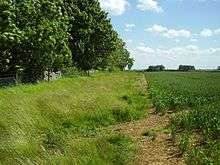Gunby and Stainby
Gunby and Stainby is a civil parish in the South Kesteven district of Lincolnshire, England. According to the 2001 Census it had a population of 141,[1] falling to 136 at the 2011 census.[2] It includes the hamlets of Gunby and Stainby.
.jpg)
For administrative purposes parish affairs are handled by the combined Colsterworth District parishes council.[3]
Geography

The only major road is the A151 Buckminster road which crosses the parish from west to east. The northern boundary lies some way north of, and very roughly parallel to this road.
The parish extends a considerable distance to the west of the villages, as far as the Lincolnshire-Leicestershire border, which forms the western edge. Out here all is farmland, over former Ironstone workings. The eastern extent reaches not quite as far as the A1 because the River Witham forms the boundary. The South is delineated by nothing more substantial than the ancient fieldlines dividing the parish from North Witham.
The land to the east, between Stainby and Gunby, is gently undulating around 125m above sea level. To the west, the contours are only about 10m higher. There is little woodland, Stainby Warren is perhaps the largest.
Stainby and Gunby are each founded around minor streams that flow from west to east into the River Witham, flowing north toward Colsterworth.[4]
Geology
The bedrock is mostly Jurassic sedimentary Ooidal ironstones of the Northampton Sand Formation. East of Gunby Road, Stainby and south of Gunby village it is Jurassic sedimentary limestone, of the lower Lincolnshire limestone series. The small streambed south of the Buckminster road is of Sedimentary Whitby mudstones, also dating back to the Jurassic.[4][5]
Ironstone mining
The west of the parish was the site of Buckminster Quarries, site of extensive ironstone mining for around a hundred years. Operations ceased in 1972. A series of industrial railways linked to the High Dyke Branch with an end-on junction at Stainby. There is now little trace of the Ironstone workings.[6][7][8]
Community
Bus route 28 (Grantham-South Witham) serves both Stainby and Gunby at times to suit schoolchildren attending schools in Grantham.[9]
See also
References
- "Gunby and Stainby" (PDF). Parish profiles. Lincolnshire research observatory. Retrieved 8 September 2013.
- "Civil Parish population 2011". Neighbourhood Statistics. Office for National Statistics. Retrieved 19 May 2016.
- "Colsterworth and District Parishes". Lincolnshire Parish Councils ; South Kesteven. Lincolnshire county council. Retrieved 8 September 2013.
Colsterworth and District Parish Council is a combined council consisting of the civil parishes of Colsterworth, (which includes the hamlet of Woolsthorpe By Colsterworth), Gunby and Stainby and recently North Witham, (which includes Lobthorpe).
- Grantham: Bottesford & Colsterworth (Map) (A1 ed.). 1:25 000. OS Explorer. Ordnance survey of Great Britain. 3 January 2006. § 247. ISBN 9780319238332.
- "Geoelogy of Britain viewer". British geological Survey. Retrieved 13 September 2013.zoom to the location, and click to identify the strata
- "Mining pictures". Colsterworth parish council. Retrieved 14 September 2013.
- "Buckminster Iron Quarry". Retrieved 14 September 2013.
- Tonks, Eric (1991). The Ironstone Quarries of the Midlands Part 8: South Lincolnshire. Cheltenham: Runpast Publishing. ISBN 1-870-754-093.
- "Centrebus 28" (PDF). Lincolnshire county council. Retrieved 14 September 2013.
- "Parish outline map". Retrieved 5 September 2013.
- "definitive footpath map" (PDF). Colsterworth district parishes council. Retrieved 8 September 2013.
External links
| Wikimedia Commons has media related to Gunby and Stainby. |
- "GUNBY & STAINBY VILLAGES". Domesday reloaded. BBC. 1986. Retrieved 8 September 2013.
- "History of Gunby, in South Kesteven and Lincolnshire". A Vision of Britain through Time. GB Historical GIS / University of Portsmouth. Retrieved 8 September 2013.
- "History of Stainby, in South Kesteven and Lincolnshire". A Vision of Britain through Time. GB Historical GIS / University of Portsmouth. Retrieved 8 September 2013.
- "all 13 historical records for the parish". Pastscape. English Heritage.